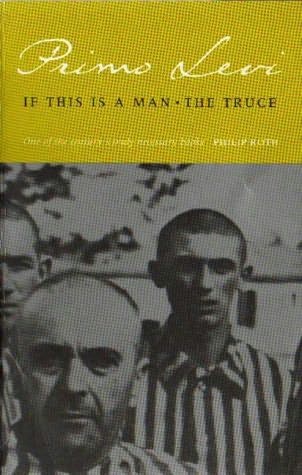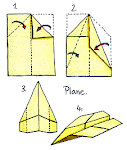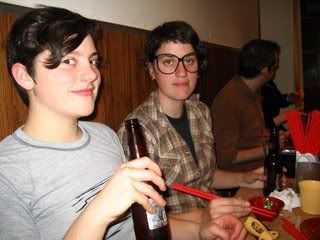Thursday, December 27, 2007
Monday, December 24, 2007
600% Fun at the Sportforum Berlin
Good times had at the Sportforum in Lichtenberg where we saw the Eisbären Berlin play the Grizzly Adams Wolfsburg. Having long been a fan of Ice Hockey (or at least the Disney classic 'The Mighty Ducks') it has long been a dream of mine to see a game, having not had too many opportunities to do so in Australia. And it really, really had it all. Grace, violence, loud music, spectacular outfits and even more spectacular chants. What more could you want? I would particularly recommend their anthem "Hey, wir wollen die Eisbären seh'n" (which approximately translates to"Yeah, We Wanna See The Polar Bears") to fans of decent techno, and I will be sure to crack it out at my next party because it has the best beat that I have ever heard in a team song. Am I conveying how much fun this event was? I hope so. It does have to be said that the atmosphere has sobered a little here since the end of the game though.
 Having done a little bit of post game research I have discovered that there is a darker side to my beloved Ice Bears, as the club was founded by the sports association of the East German Police, Volkspolizei and the secret service, MfS (better known as the Stasi). But hey, how much can you hold against a big furry logo? Nothing is going to ruin my memories of the best day had with the Ice Bears. Oh yeah, they won by the way.
Having done a little bit of post game research I have discovered that there is a darker side to my beloved Ice Bears, as the club was founded by the sports association of the East German Police, Volkspolizei and the secret service, MfS (better known as the Stasi). But hey, how much can you hold against a big furry logo? Nothing is going to ruin my memories of the best day had with the Ice Bears. Oh yeah, they won by the way.

Pilgrims setting off for the game
The players in action
Saturday, December 22, 2007
Thursday, December 20, 2007
If This Is a Man / The Truce

Se questo è un uomo/La Tregua
"It is not at all an idle matter trying to define what a human being is."
Finally got down to reading these books after many years- taking some stern advice from the title of one of Levi's other titles 'If not now when?'
His memoirs begin shortly after the collapse of Mussolini's regime, and opens with Levi trying to contact a partisan group in the north of Italy as a very inexperienced young man. "I was twenty-four with little wisdom, no experience and a decided tendency ... to live in an unrealistic world of my own, a world inhabited by civilized Cartesian phantoms, by sincere male and bloodless female friendships." He is captured shortly after joining the partisans in December 1943 and sent to Auschwitz.
This memoir then tells the tale of Levi working as a slave labourer at a company making synthetic rubber for the Nazi war economy. Through a variety of accidents, a friendship with a non-Jewish guest working and by happening to know that he could safely eat cotton wool and drink paraffin (because he was a trained Chemist) he is spared the gas chamber. Almost every other character is dead by the end of the book, and the closing pages of the festering snowfields of Auschwitz after the Nazi's flee are probably the most horrifying passages of writing that I have ever read.
Liberated by the Soviets in January 1945, its sequel, The Truce, tells of Levi's hungry wanderings in war-torn eastern Europe in Poland, Belorussia, the Soviet Union, Hungary, and Romania, and really opened my eyes to how little the survivors of the war were attended to at all. Levi eventually returns home on the last pages of his account after a year of trying to get there, but he has a continual nightmare in which his present life turns out to be a mere illusion and he wakes up with Auschwitz's morning call: "Wstawac" (get up).
As usual I hesitate to actually write what I think in any detail about these excellent books , but hey, I can sure post a link to one here.
Tuesday, December 11, 2007
Herr Lehmann

One of my new favourite films that made me love Kreuzberg just a bit more than I already did: Herr Lehmann. It tells the story of Frank Lehmann, a bar tender living in the 3036 borough of Kreuzberg back in 1989 just before the wall came down. Largely shut off by the Wall from the rest of West Berlin for 28 years it was (and is) a notorious sub-culture of students, artists, bohemians and immigrants living amongst the crumbling buildings. The film goes through the usual subjects you'd expect from a film about 20 somethings, but what really made it memorable for me was Herr Lehmanns visit to the East to drop off some money to a relative and his interrogation by the Stasi, and the strong sense throughout the film that the East and West could and would never be reunified. So of course the film ends to the wall coming down, and its a great scene, giving you some sense of the excitement and joy that the moment must have held for so many people, in Berlin and everywhere else too.
The soundtrack is pretty fun too, full of the Eels, Ween, Cake and the Violent Femmes. Not very 1989, but anyway...
Saturday, December 8, 2007
Haus der Wannsee-Konferenz
Now and Then

 Today Steph and I took the S7 train to the end of the line out to the Wannsee Lakes to see if manage to say "I bet this must be beautiful in Summer" during our stay in Berlin. And really, it must be. Since it was raining we weren't keen on staying out in the cold for too long so we jumped on a bus and soon found ourselves outside of the front gate to the House of the Wannsee Conference. On January 20th, 1942, fourteen select German civil servants and SS-officers met here to discuss the implementation of "The Final Solution," the extermination of European Jews. It's basically considered to be the site of the turning point from the regime murdering Jews en masse to the regime planning their extermination in a cohered way. All in all, a pretty eerie place.
Today Steph and I took the S7 train to the end of the line out to the Wannsee Lakes to see if manage to say "I bet this must be beautiful in Summer" during our stay in Berlin. And really, it must be. Since it was raining we weren't keen on staying out in the cold for too long so we jumped on a bus and soon found ourselves outside of the front gate to the House of the Wannsee Conference. On January 20th, 1942, fourteen select German civil servants and SS-officers met here to discuss the implementation of "The Final Solution," the extermination of European Jews. It's basically considered to be the site of the turning point from the regime murdering Jews en masse to the regime planning their extermination in a cohered way. All in all, a pretty eerie place.After WW2 it was used by the American occupation force for a few years, and then strangely enough, it was used as a Youth Hostel until the early 1990's when it was converted to this memorial and opened for the 50th Anniversary of the Conference. Wannsee remains a really affluent area to this day, and as we left I couldn't be sure whether it the memories of the exhibit or the oh so obscene wealth around me that was creeping me out more.
Friday, December 7, 2007
speak the password primeval at the HAMBURGER BAHNHOF
Right near the top of the list was the room just full of creepy creepy Paul McCarthy fun. The show featured a lot of his videotaped performances, often spreading ketchup or saliva all over his naked body, having sex with his bed, or just beating the crap out of himself. In Tubbing he just seems to jams sausages into his mouth and arse. He might have done some other things but it got a little boring after awhile and I had to move on. I was particularly excited to final see 'Santa Chocolate Shop' which I thought seemed about the coolest thing when I was a teenager pouring over the 'Transgressive Art' section in Matthew Colling's This is Modern Art. It seems that I haven't come so far since then because somehow a large, tipped-over cottage with video projections of a red-nosed reindeer humping an elf and a demented Santa shitting chocolate into the mouth of a female helper still did it for me. All in all almost certainly misogynist, fairly funny, dull in parts, but overall strangely hypnotic. Great way to start of the Christmas season anyway. http://mccarthy.smak.be/
BUT THE THING I GOT REALLY EXCITED ABOUT was smack in the middle of the end of a ridiculously long hall which I later found out was an installation by Jason Rhoades called “A Few Free Years”. I didn't know that at the time because I was already too busy playing the REAL 80s and 90s arcade games that faced each other to make a kind of corridor in the gallery. Terminator 2, Tetris, Joust, that car game I can't remember the name of, they were all here with an unlimited amount of credits on them. I have since read that it was meant to be some sort of tribute to Beethoven's 9 Symphony, and I don't really know about that. What I do know is that it was a damn good afternoon in the artwork, and I know I must have been there for awhile because my ears are still ringing with the tinny sounds that made up a fairly large chunk of my childhood spent in front of an atari, a super nintendo, the arcades at Balcatta Rollerdrome and Hillary's Boat Harbour. If only they had Bubble Bobble, it would have been like a time warp in there. Perhaps not the most challenging work I've ever seen, but still.
Wednesday, December 5, 2007
Die Gedenkstätte Deutscher Widerstand
 Yesterday we visited the German Resistance Memorial Center (Die Gedenkstätte Deutscher Widerstand) a permanent exhibition documenting a spectrum of German resistance to National Socialism. This exhibition exists in the historic rooms of the attempted coup of July 20, 1944, on a street that has since been named "Stauffenbergstrasse" after the colonel that tried to assassinate Hitler in 1944. The courtyard is in the center of the Bendlerblock, the former headquarters of the German Army High Command; the bronze figure of a young man with bound hands pays tribute to Stauffenberg and his co-conspirators of the Valkyrie plot, who were executed immediately after the blast that failed to kill Hitler.
Yesterday we visited the German Resistance Memorial Center (Die Gedenkstätte Deutscher Widerstand) a permanent exhibition documenting a spectrum of German resistance to National Socialism. This exhibition exists in the historic rooms of the attempted coup of July 20, 1944, on a street that has since been named "Stauffenbergstrasse" after the colonel that tried to assassinate Hitler in 1944. The courtyard is in the center of the Bendlerblock, the former headquarters of the German Army High Command; the bronze figure of a young man with bound hands pays tribute to Stauffenberg and his co-conspirators of the Valkyrie plot, who were executed immediately after the blast that failed to kill Hitler. But thats not the only emphasis of the museum. More than 5,000 photographs and documents present examples of the motives, actions, and goals of individuals, groups, and organizations involved in resistance to National Socialism. The resistors in the Labor Movement, the Communist Party and from Christian organisations are also represented here, and this for me made the visit much more worthwhile. The tales of people like Liselotte Herrmann or Walter Uhlmann who, like Luxemburg and Liebknecht before them, stood up for the working class and against Nazism long before 1944 are here, and for me are the real heroes of the Nazi era, not a few Colonels who decided to turn on their leader when their imperialist war was clearly lost- like drowned rats at the 11th hour. This is a link to a few of the biographies of resisters from the labor movement before 1939. http://www.gdw-berlin.de/b04/b04-bio-e.php#
But thats not the only emphasis of the museum. More than 5,000 photographs and documents present examples of the motives, actions, and goals of individuals, groups, and organizations involved in resistance to National Socialism. The resistors in the Labor Movement, the Communist Party and from Christian organisations are also represented here, and this for me made the visit much more worthwhile. The tales of people like Liselotte Herrmann or Walter Uhlmann who, like Luxemburg and Liebknecht before them, stood up for the working class and against Nazism long before 1944 are here, and for me are the real heroes of the Nazi era, not a few Colonels who decided to turn on their leader when their imperialist war was clearly lost- like drowned rats at the 11th hour. This is a link to a few of the biographies of resisters from the labor movement before 1939. http://www.gdw-berlin.de/b04/b04-bio-e.php# Another really touching part of the exhibition was the documentation of the White Rose group, a group of a few students in their early twenties (including Sophie Scholl, her brother Hans, Alex Schmorell, Willi Graf and Christoph Probst, and a professer at their University called Kurt Huber) who prepared and distributed six different leaflets calling for the active opposition of the German people to Nazi oppression and tyranny between June 1942 and February 1943. They were caught during the distribution of the of the seventh leaflet and sentenced to death. Today they really typify the officially recognised opposition to the war, and the White Rose groups stylistically sophisticated leaflets and diary entries are still quoted in length by anti-war activists today who look to passive resistance.Here’s a particularly moving quotation from Sophie, written soon before her death in 1943:
Another really touching part of the exhibition was the documentation of the White Rose group, a group of a few students in their early twenties (including Sophie Scholl, her brother Hans, Alex Schmorell, Willi Graf and Christoph Probst, and a professer at their University called Kurt Huber) who prepared and distributed six different leaflets calling for the active opposition of the German people to Nazi oppression and tyranny between June 1942 and February 1943. They were caught during the distribution of the of the seventh leaflet and sentenced to death. Today they really typify the officially recognised opposition to the war, and the White Rose groups stylistically sophisticated leaflets and diary entries are still quoted in length by anti-war activists today who look to passive resistance.Here’s a particularly moving quotation from Sophie, written soon before her death in 1943:
“The real damage is done by those millions who want to ’survive.’ The honest men who just want to be left in peace. Those who don’t want their little lives disturbed by anything bigger than themselves. Those with no sides and no causes. Those who won’t take measure of their own strength, for fear of antagonizing their own weakness. Those who don’t like to make waves or enemies. Those for whom freedom, honour, truth, and principles are only literature. Those who live small, mate small, die small. It’s the reductionist approach to life: if you keep it small, you’ll keep it under control. If you don’t make any noise, the bogeyman won’t find you. But it’s all an illusion, because they die too, those people who roll up their spirits into tiny little balls so as to be safe. Safe?! From what? Life is always on the edge of death; narrow streets lead to the same place as wide avenues, and a little candle burns itself out just like a flaming torch does. I choose my own way to burn.”
The quote has some problems, but from a group of young people isolated from the tiny underground workers organisations fighting the Nazi's, very inspiring nonetheless.

Tuesday, December 4, 2007
Spielwiese Ludotek

Fun had at Spielwiese, the coffee bar across the road where you can spend an evening playing one or three of the 999 games available for 1€. The bright interior with its retro design fits in well here in Friedrichshain, and walking past the shop every day for a month and a half gave me enough time to build up some serious anticipation for a night of boardgaming.
I wanted to play Risk. Pretty bad. Here in Germany it is called "Riskito" and that made me want to play it even more. They even had 6 versions, and that put me into into a place of major Risk need. Despite some serious attempts to convince, cajole and then sulk into getting my way at the Spielwiese this evening I lost the vote, and instead we spent the night listening to the panicky buzz of Operation, or "Doktor Bibber" as it is known here. Here is me sulking some more over a hot game of Bibber.

Here is steph getting out a charlie horse.

And here is just some fun lovin guys at the Spielwiese.
http://www.spielwiese-berlin.de/










